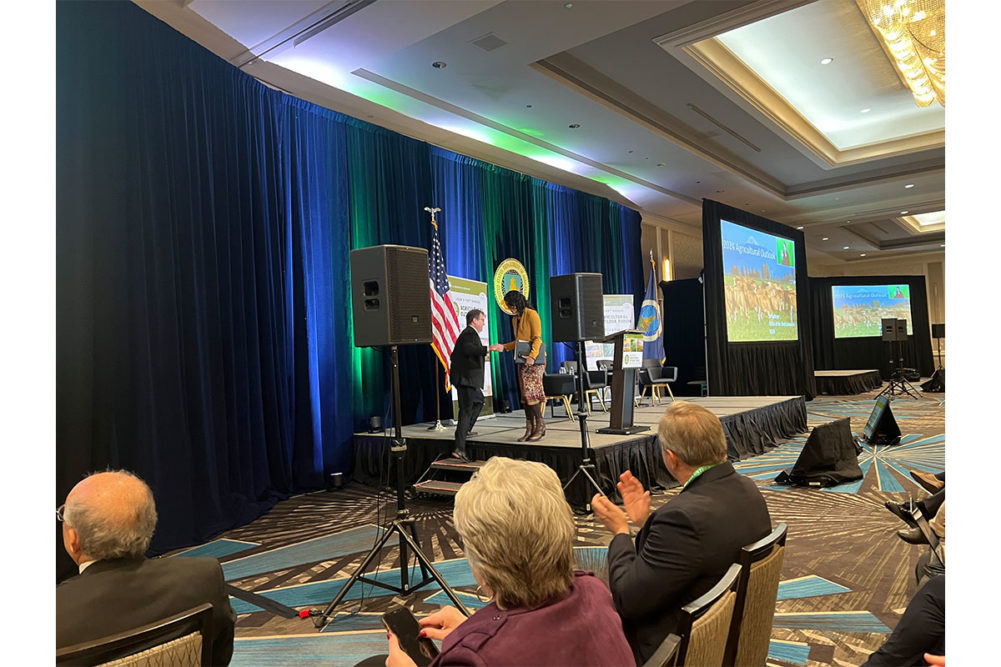WASHINGTON — Higher soybean acres and lower corn and wheat acres are projected for 2024 amid prices near three-year lows, a result of numerous price pressures and challenges facing US agriculture this year, the US Department of Agriculture’s top agricultural economist told attendees Feb. 15 at the 100th annual Agricultural Outlook Forum.
Welcoming remarks from Xochitl Torres Small, deputy secretary of agriculture, opened the conference at Crystal Gateway Marriott in Arlington, Va. Her remarks quickly segued into a much-anticipated annual outlook from USDA chief economist Seth Meyer.
Meyer said the biggest surprises in 2023 agriculture were the flexibility of US farmers to respond to market signals and change their cropping, responding to the global need for more corn and wheat as the Russia-Ukraine war extended into a second year. He also noted farmers’ resilience in their production in a challenging year, citing as an example record corn yields despite drought conditions covering a large portion of US corn areas.
US agriculture in 2024 begins with a greater carryover cushion for corn and soybeans but lower rice and wheat stockpiles, Meyer said. Prices have been moving steadily lower from a peak just after Russia invaded Ukraine (in February 2022). That trend is expected to continue, he said. Challenges include the tremendous growth in South American soybean production at a time when Chinese demand is no longer growing 4% to 8% a year.
Wheat seeded area and prices were expected to decline, Meyer said, partly on Ukraine establishing an alternate pathway out of the Black Sea that has allowed that country’s grain exports to rebound near levels recorded when the Black Sea Grain Initiative agreement with Russia was in place.
“The Black Sea remains more than 30% of the global market for trade in wheat,” Meyer said. “The Russians have had two huge crops of wheat, and they are pushing it out. With tighter stocks, why have wheat prices been on the decline? Part of it is Russia pushing big supplies of cheap wheat onto the global market. So we’re facing some low-price competitiveness, and while we might rebound off of our 50-plus-year low on exports, it’s still going to be a problematic year or couple of years.”
The Grains and Oilseeds Outlook issued concurrent to the morning session indicated the USDA projects the area seeded to all wheat at 47 million acres, down 2.6 million acres from 49.6 million acres in 2023 but above the acreage seeded in 2018-22.
Area planted to corn in 2024 was projected at 91 million acres, down 3.6 million from 94.6 million acres in 2023 but up in comparison with 88.2 million corn acres seeded in 2022.
Soybean acres in 2024 are expected to increase to 87.5 million acres, up 3.9 million from 83.6 million acres in 2023, but steady in comparison with 2022, tied for most acres since 89.2 million in 2018.
“The challenge is weather, will always be whether farmers can get it in the field or not,” Meyer said. “But our headline picture here is that maybe prices support soybeans a little more than corn, so maybe we move a little bit of area back into soybeans. Sorghum areas are largely unchanged. Wheat, after responding to global demand because of action in the Black Sea, farmers now say maybe we move some acres back out. Cotton being one of the areas where we see perhaps some acres growth and certainly if weather is normal, some big rebounds in production. Rice, pretty steady overall in area. This is based purely on the economics now. Things will change when farmers enter the field.”
Meyer introduced the keynote speaker, US Secretary of Agriculture Tom Vilsack, who said the forum presents a chance for a detailed look at what the next 12 months hold.
“My job is not to look at the trees, but look at the forest, to elevate the conversation,” Vilsack said. “I would suggest to you we have to think about not just the agricultural production story, but the societal story as well. The importance of rural America to this country and its value system, and whether or not as we focused principally and primarily on productivity, did we forget about the societal price we had to pay.”
Vilsack’s speech was interrupted for a few minutes by a protester claiming more than a billion tax dollars were spent to bail out the chicken industry following a “bird flu” epidemic. The chief economist’s efforts to halt the interruption were to no avail.
“I’ve been accused of not caring much about agriculture, and now I’m being told I care too much about it,” Vilsack said to laughter and applause from the crowd before the protester and an accomplice marched out chanting “stop the bird flu bailout.”




